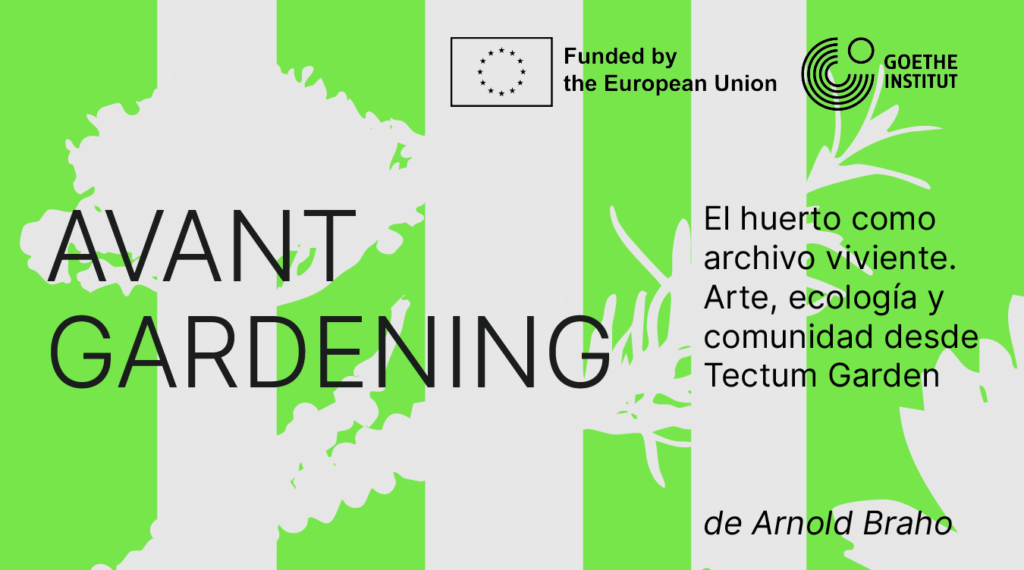Art, Ecology and Community from Tectum Garden
de Arnold Braho
As part of the Culture Moves Europe programme, promoted by the European Union and the Goethe-Institut, a collaboration is currently underway with the organization Tectum Garden in Barcelona. The project begins with a central question: How can we rethink the urban garden not only as a space for cultivation but also as a site of cultural, social, and political construction?
Tectum Garden, with its strong commitment to urban agriculture and sustainable practices, aligns with curatorial research that explores the intersections between contemporary art and ecology. Within this context, the urban garden is envisioned as a symbolic laboratory—a site for the production of discourse, narratives, and community, where knowledge, resistance, and new horizons of possibility converge. Everyday activity within the garden takes on both political and cultural significance.
This collaboration has led to the development of a cultural programme—currently being shaped in partnership with Pietro Tonini—which includes workshops, labs, and public presentations. The programme is also set to expand to Italian educational institutions, with activities planned at NABA in Milan and IUAV in Venice. In parallel, a series of video art projects are being curated, addressing themes such as urban agriculture and ecology, with screenings scheduled during cultural events in Barcelona.
Far from a nostalgic vision, urban agricultural practice is framed as a contemporary space of possibility, interconnection, and the creation of new social narratives. The garden becomes a catalyst for social cohesion—a site of intergenerational, intercultural, and transdisciplinary encounter where learning hierarchies are suspended and knowledge circulates horizontally.
From both ecological and symbolic perspectives, the urban garden functions as a living and dynamic system: a sink for organic waste that encourages circularity, where refuse is not discarded but rather transformed matter. Simultaneously, it acts as a biodiversity hub, interlacing green corridors that render the urban environment more permeable to wildlife. This contributes to a post-human vision in which humans are regarded as one species among many within a complex and interdependent system. In some contexts, the garden also assumes a spiritual and introspective role, serving as a space for intimate connection with the land and ancestral practices.
This multidimensional nature—pedagogical, ecological, symbolic, and political—poses significant challenges to artistic and curatorial practices. There is a critical need to avoid representations that lead to exoticization, musealization, or idealization. The central question becomes: How can we create frameworks for knowledge and visibility that acknowledge the complexity, power, and diversity of these practices without replicating extractive or colonial logics?
In this regard, semiotics and curatorial practice emerge as essential critical tools. They dismantle dominant narratives, open up new ways of reading and naming, contribute to the decolonization of established categories, and propose narratives that broaden the experiential field of contemporary art. Art, from this perspective, can play an active role in bringing visibility and value to these practices, positioning them as expressions of contemporary, political, and locally grounded sensibilities.
A central axis of the project is the declaration of the garden as a shared and common cultural space. This underlines the possibility of understanding the act of cultivation not only as agricultural but also as a space of thought, emotional resonance, and symbolic contestation. The aim is not to romanticize agricultural practices, but to recognize in them a reservoir of social imagination—a fertile ground from which to rethink the common, the political, and the sensitive.
The garden is also presented as a living archive: a dynamic depository of ancestral knowledge, techniques passed down orally across generations, collective memories, and plant species that resist the homogenization of the landscape. This archival dimension ties closely to the vision of the garden as both a site of resistance and of future-making—where alternative practices emerge that question agro-industrial systems and open up possibilities for more just and sustainable ways of living together.
Within this framework, the collaboration with Tectum Garden stands as an active platform to explore these lines of inquiry, unfolding at the intersection of curatorial research, ecological thought, and contemporary cultural practice.
The ongoing programme—which includes workshops, public presentations, and video art—functions as a structure for dialogue and action that links art, ecology, and community through a critical, situated, and transdisciplinary lens.
